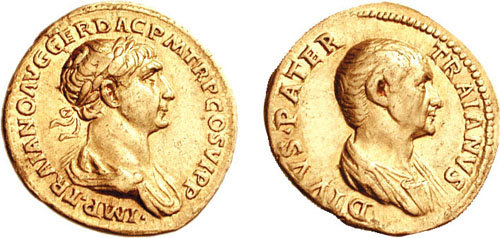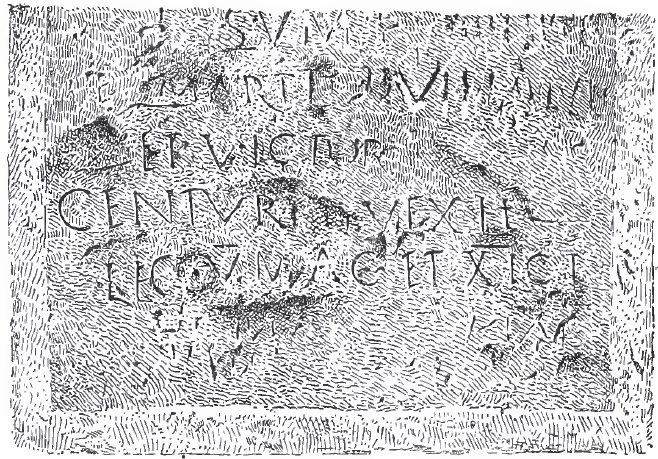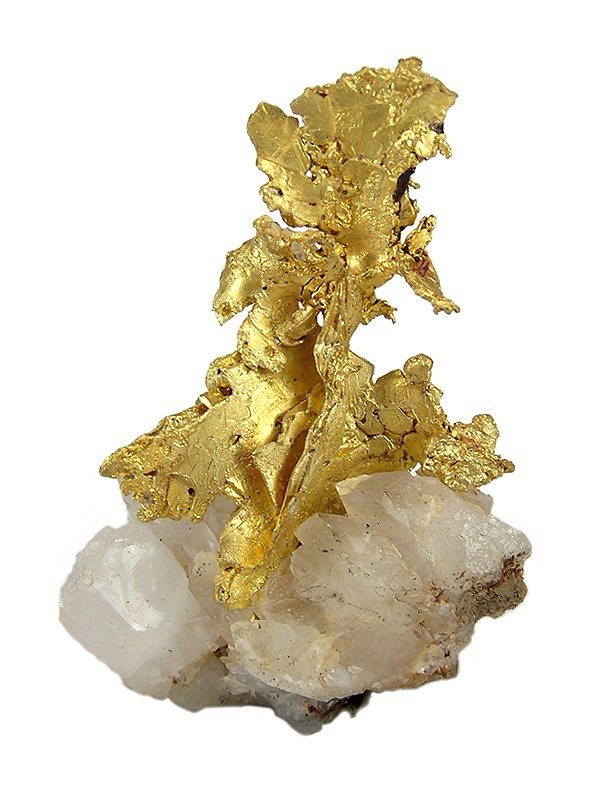|
Castra Of Războieni-Cetate
The castra of Războieni-Cetate was a fort in the Roman province of Dacia. See also *List of castra Castra (Latin, singular castrum) were military forts of various sizes used by the Roman army throughout the Empire in Europe, Asia and Africa. The largest castra were permanent legionary fortresses. Locations The disposition of the castra refl ... External linksRoman castra from Romania - Google MapsEarth Notes Roman Dacia Roman auxiliary forts in Romania Ancient history of Transylvania Historic monuments in Alba County {{Dacia-stub ... [...More Info...] [...Related Items...] OR: [Wikipedia] [Google] [Baidu] |
Trajan
Trajan ( ; born Marcus Ulpius Traianus, 18 September 53) was a Roman emperor from AD 98 to 117, remembered as the second of the Five Good Emperors of the Nerva–Antonine dynasty. He was a philanthropic ruler and a successful soldier-emperor who presided over one of the greatest military expansions in Roman history, during which, by the time of his death, the Roman Empire reached its maximum territorial extent. He was given the title of ('the best') by the Roman Senate. Trajan was born in the of Italica in the present-day Andalusian province of province of Seville, Seville in southern Spain, an Italic peoples, Italic settlement in Hispania Baetica; his came from the town of Todi, Tuder in the Regio VI Umbria, Umbria region of central Italy. His namesake father, Marcus Ulpius Traianus (father of Trajan), Marcus Ulpius Traianus, was a general and distinguished senator. Trajan rose to prominence during the reign of Domitian; in AD 89, serving as a in , he supported t ... [...More Info...] [...Related Items...] OR: [Wikipedia] [Google] [Baidu] |
Legio XIII Gemina
, in English the 13th "Twin" Legion was a legion of the Imperial Roman army. It was one of Julius Caesar's key units in Gaul and in the civil war, and was the legion with which he crossed the Rubicon in January, perhaps on 10 January, in 49 BC. The legion appears to have still been in existence in the 5th century AD. Its symbol was the lion. History Under the late Republic Legio XIII was levied by Julius Caesar in 57 BC, before marching against the Belgae, in one of his early interventions in intra-Gallic conflicts. During the Gallic Wars (58–51 BC), Legio XIII was present at the Battle against the Nervians, the Siege of Gergovia, and while not specifically mentioned in the sources, it is reasonable to assume that Legio XIII was also present for the Battle of Alesia. After the end of the Gallic wars, the Roman Senate refused Caesar his second consulship, ordered him to give up his commands, and demanded he return to Rome to face prosecution. Forced to choose either ... [...More Info...] [...Related Items...] OR: [Wikipedia] [Google] [Baidu] |
Legio V Macedonica
Legio V Macedonica (the Fifth Macedonian Legion) was a Roman legion. It was established in 43 BC by consul Gaius Vibius Pansa Caetronianus and Augustus, Gaius Julius Caesar Octavianus (later known as the Roman Emperor, Emperor Augustus). and based in the Balkan provinces of Macedonia (Roman province), Macedonia, Moesia and Dacia. In the Notitia Dignitatum records from beginning of the fifth century, the legion was still stationed in Dacia, with detachments stationed in the east and Egypt. The last known evidence shows the legion, or detachments from it, stationed in Egypt in the seventh century one or two years before the Islamic conquest of Egypt. It is often assumed that the legion fought in this war and was destroyed, although it is uncertain whether detachments or the whole legion were in Egypt, and there is no further evidence of the legion's eventual fate. Its symbol was the bull, but the eagle was used as well. History 1st century BC: Creation and deployment in Maced ... [...More Info...] [...Related Items...] OR: [Wikipedia] [Google] [Baidu] |
Ala I Batavorum Milliaria
Ala, ALA, Alaa, or Alae may refer to: Codes * Åland Islands, ISO 3166-1 alpha-3 code * Åland, ISO 3166-1 country code * Former NYSE stock symbol of Alcatel; see Alcatel-Lucent * Almaty International Airport, IATA code Military * , a US Navy tugboat * Ala (Roman allied military unit), a Republican-period, largely infantry, formation of 5,400 men * Ala (Roman cavalry unit), an Imperial-period, purely cavalry, formation of 500 men * American Legion Auxiliary * Arab Liberation Army * Arakan Liberation Army Mythology and religion * Ala (demon), a female demon in Serbian mythology * Ala (Luwian goddess), a Hittite and Luwian goddess * Ala (Odinani), an Alusi (deity) in the Odinani beliefs of the Igbo people of Nigeria Organizations * African Leadership Academy * Alleanza Liberalpopolare – Autonomie, an Italian political party * Allgemeine Anzeigen GmbH * American Latvian Association * American Leadership Academy * American Legion Auxiliary * American Library Association ... [...More Info...] [...Related Items...] OR: [Wikipedia] [Google] [Baidu] |
Dacia
Dacia (, ; ) was the land inhabited by the Dacians, its core in Transylvania, stretching to the Danube in the south, the Black Sea in the east, and the Tisza in the west. The Carpathian Mountains were located in the middle of Dacia. It thus roughly corresponds to present-day Romania, as well as parts of Moldova, Bulgaria, Serbia, Hungary, Slovakia, Czech Republic, Poland and Ukraine. A Dacian kingdom that united the Dacians and the Getae was formed under the rule of Burebista in 82 BC and lasted until the Roman conquest in AD 106. As a result of the Trajan's Dacian Wars, wars with the Roman Empire, after the conquest of Dacia, the population was dispersed, and the capital city, Sarmizegetusa Regia, was destroyed by the Romans. However, the Romans built a settlement bearing the same name, Ulpia Traiana Sarmizegetusa, Ulpia Traiana Sarmizegetuza, 40 km away, to serve as the capital of the newly established Roman Dacia, Roman province of Dacia. A group of "Free Dacians" may ... [...More Info...] [...Related Items...] OR: [Wikipedia] [Google] [Baidu] |
Dacia Superior
Roman Dacia ( ; also known as ; or Dacia Felix, ) was a province of the Roman Empire from 106 to 271–275 AD. Its territory consisted of what are now the regions of Oltenia, Transylvania and Banat (today all in Romania, except the last region which is split among Romania, Hungary, and Serbia). During Roman rule, it was organized as an imperial province on the borders of the empire. It is estimated that the population of Roman Dacia ranged from 650,000 to 1,200,000. It was conquered by Trajan (98–117) after two campaigns that devastated the Dacian Kingdom of Decebalus. However, the Romans did not occupy its entirety; Crișana, Maramureș, and most of Moldavia remained under the Free Dacians. After its integration into the empire, Roman Dacia saw constant administrative division. In 119 under Hadrian, it was divided into two departments: Dacia Superior ("Upper Dacia") and Dacia Inferior ("Lower Dacia"; later named Dacia Malvensis). Between 124 and around 158, Dacia Superi ... [...More Info...] [...Related Items...] OR: [Wikipedia] [Google] [Baidu] |
Alba County
Alba County () is a county (județ) of Romania located in the historic region of Transylvania. Its capital is Alba Iulia, a city with a population of 63,536. Name "Alba", meaning "white" in Latin and Romanian, is derived from the name of the city of Alba Iulia. In Hungarian language, Hungarian, the county is known as ''Fehér megye'' (fehér also meaning white), and in German language, German as ''Kreis Karlsburg''. Geography This county has a total area of , with mountains occupying about 59% of its surface. The Apuseni Mountains are in the northwest; the northeastern side of the Parâng Mountains group – the Șureanu Mountains, Șureanu and Cindrel Mountains, Cindrel mountains – are in the south. In the east there is the Transylvanian Plateau with deep but wide valleys. The three main elements are separated by the Mureș (river), Mureș River valley. The main rivers are the Mureș (river), Mureș River and its tributaries, the Târnava, the Sebeș (river), Sebeș, ... [...More Info...] [...Related Items...] OR: [Wikipedia] [Google] [Baidu] |
Castra
''Castra'' () is a Latin language, Latin term used during the Roman Republic and Roman Empire for a military 'camp', and ''castrum'' () for a 'Fortification, fort'. Either could refer to a building or plot of land, used as a fortified military base.. Included is a discussion about the typologies of Roman fortifications. In English language, English usage, ''castrum'' commonly translates to "Roman fort", "Roman camp" and "Roman fortress". Scholastic convention tends to translate ''castrum'' as "fort", "camp", "marching camp" or "fortress". Romans used the term ''castrum'' for different sizes of camps – including large Roman legion, legionary fortresses, smaller forts for Cohort (military unit), cohorts or for auxiliary forces, military camp, temporary encampments, and "marching" forts. The diminutive form ''castellum'' was used for fortlets, typically occupied by a detachment of a cohort or a ''centuria''. Etymology ''Castrum'' appears in Oscan language, Oscan and Umbrian ... [...More Info...] [...Related Items...] OR: [Wikipedia] [Google] [Baidu] |
Roman Province
The Roman provinces (, pl. ) were the administrative regions of Ancient Rome outside Roman Italy that were controlled by the Romans under the Roman Republic and later the Roman Empire. Each province was ruled by a Roman appointed as Roman governor, governor. For centuries, it was the largest administrative unit of the foreign possessions of ancient Rome. With the administrative reform initiated by Diocletian, it became a third level administrative subdivision of the Roman Empire, or rather a subdivision of the Roman diocese, imperial dioceses (in turn subdivisions of the Praetorian prefecture, imperial prefectures). History A province was the basic and, until the Tetrarchy (from AD 293), the largest territorial and administrative unit of the empire's territorial possessions outside Roman Italy. During the republic and early empire, provinces were generally governed by politicians of Roman senate, senatorial rank, usually former Roman consul, consuls or former praetors. ... [...More Info...] [...Related Items...] OR: [Wikipedia] [Google] [Baidu] |
Roman Dacia
Roman Dacia ( ; also known as ; or Dacia Felix, ) was a province of the Roman Empire from 106 to 271–275 AD. Its territory consisted of what are now the regions of Oltenia, Transylvania and Banat (today all in Romania, except the last region which is split among Romania, Hungary, and Serbia). During Roman rule, it was organized as an imperial province on the borders of the empire. It is estimated that the population of Roman Dacia ranged from 650,000 to 1,200,000. It was conquered by Trajan (98–117) after two campaigns that devastated the Dacian Kingdom of Decebalus. However, the Romans did not occupy its entirety; Crișana, Maramureș, and most of Moldavia remained under the Free Dacians. After its integration into the empire, Roman Dacia saw constant administrative division. In 119 under Hadrian, it was divided into two departments: Dacia Superior ("Upper Dacia") and Dacia Inferior ("Lower Dacia"; later named Dacia Malvensis). Between 124 and around 158, Dacia Sup ... [...More Info...] [...Related Items...] OR: [Wikipedia] [Google] [Baidu] |







